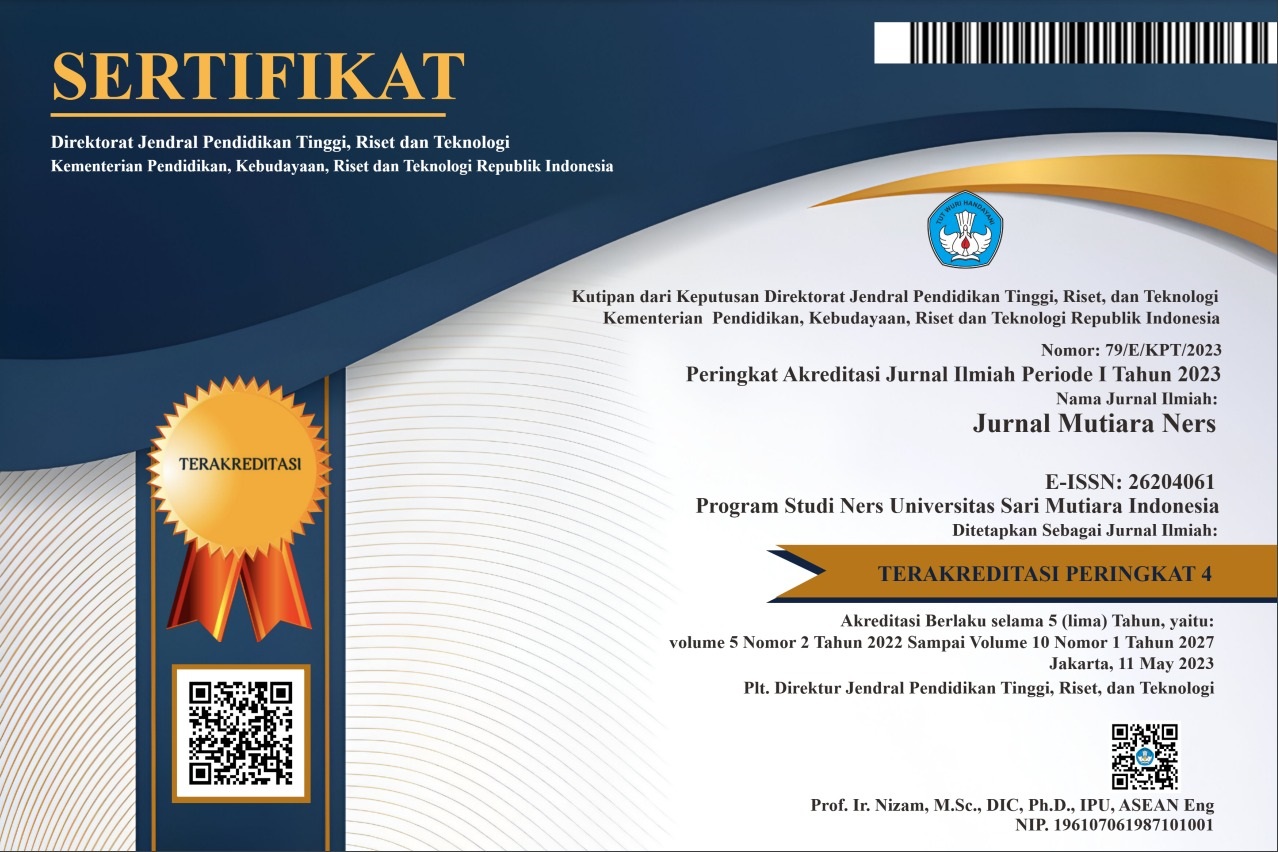PERAN PIMPINAN KEPERAWATAN DALAM MENINGKATKAN PATIENT SAFETY DI RUMAH SAKIT
Keywords:
Patient safety, Role of leader.Abstract
Patient Safety is a patient who is free from potential injury either happen or not as illness, injury and death in health care. In terms of improving patient safety required elements of leadership roles in the field of nursing care program encourages patient safety, reduce the incidence of unintended communication in decision making patient safety, adequate resources and the effectiveness of the contribution in improving patient safety. The purpose of research is to identify the role of leader of the field of nursing services in improving patient safety diruang inpatient Elizabeth Hospital Medan in 2016. The study design was descriptive. Mechanical sampling using non-random sampling (non-probability) with the formula Slovin, totaling 143 respondents using questionnaires leadership role in the field of nursing services improve patient safety with 24 questions ordinal scale. The results obtained by univariate analysis the role of elements of leadership to the field of nursing services in improving patient safety in the inpatient unit Elizabeth Hospital Medan in 2016 found that the highest, respondents expressed either as many as 97 people (67.8%), and a low of respondents stating quite as many as 46 people (32.2%). Expected led the field of nursing services can still play an increasing role in improving patient safety in the inpatient unit Elizabeth Hospital Medan to maintain the quality of nursing services.
Downloads
References
Badeni. (2014). Kepemimpinan & Perilaku Organisasi. Bandung: Alfabeta
Budiono, dkk. (2014). Pelaksanaan Program Manajemen Pasien dengan Risiko Jatuh di Rumah Sakit. (jurnal.kedokteranbrawijaya.ac.id/index.php/article/download/vol.2.pdf, diakses pada tanggal 8 April 2015)
Departemen Kesehatan RI. (2008). Panduan Nasional Keselamatan Pasien di Rumah Sakit (Patient Safety). Jakarta: Depkes RI
Dewi, Mursidah. (2012). Pengaruh Pelatihan Timbang Terima Pasien Terhadap Penerapan Keselamatan Pasien Oleh Perawat Pelaksana di RSUD Raden MattaherJamb.(http://ejurnal.ung.ac.id/index.php/JHS/article/download/911/851.pdf, diakses pada tanggal 7 April 2015)
Djasri, H. (2006). Penerapan Clinical Governance Melalui ISO 9000 Studi Kasus Di Dua RSUD Provinsi Jawa Timur. Jurnal Manajemen Pelayanan Kesehatan, Volume 09 No. 03
Nurmalia, Devi, dkk. Pengaruh Program Mentoring Terhadap Penerapan Budaya Keselamatan Pasien. (http://jurnal.unimus.ac.id/index.php/JMK/article/download/1002/1051)
Fahmi, Irham. (2014). Manajemen Kepemimpinan Teori & Aplikasi. Bandung: Alfabeta
Faizin, Achmad & Winarsih. (2008). Hubungan Tingkat Pendidikan Dan Lama Kerja Perawat Dengan Kinerja Perawat Di Rsu Pandan Arang Kabupaten Boyolali. (https://publikasiilmiah.ums.ac.id/scholar/11617/499/pdf, diakses pada tanggal 4 April 2015)
Ghofar, Abdul. (2015). Pengaruh Strategi Manufaktur terhadap Kinerja (Studi pada Industri Manufaktur Menengah dan Besar di Yogyakarta. (http://majour.maranatha.edu/index.php/jurnal-manajemen/article/view/1363. pdf, diakses pada tanggal 4 April 2015)
Hidayat, A. Aziz Alimut. (2007). Metodologi Penelitian Keperawatan Dan Teknik Analisa Data. Jakarta: Salemba Medika
KemenKes RI. (2011). Standar Akreditasi Rumah Sakit. Jakarta: Kementerian Kesehatan RI
Komite Keselamatan Pasien - Rumah Sakit (KKP-RS). Ed.2. (2008). Pedoman Pelaporan Insiden Keselamatan Pasien. Jakarta: Persi
Mubarak, dkk. (2015). Buku Ajar Ilmu Keperawatan Dasar. Jakarta: Salemba Medika
Notoatmodjo, Soekidjo. (2005). Metodologi Penelitian Kesehatan. Jakarta: Rineka Cipta
Notoatmodjo, Soekidjo. (2012). Metodologi Penelitian Kesehatan. Jakarta: Rineka Cipta
Nursalam, (2008). Metodologi Penelitian Ilmu Keperawatan Pendekatan Praktis, Edisi 1. Jakarta: Salemba Medika
Nursya. (2013). Hubungan Kepemimpinan Efektif Kepala Ruangan Dengan Penerapan Budaya Keselamatan Pasien Di Instalasi Rawat Inap RS UNHAS. (http://repository.unhas.ac.id/140613.pdf, diakses tanggal 30 November 2015)
Peraturan Menteri Kesehatan Nomor 1691. (2011). Tentang Keselamatan Pasien Rumah Sakit. Jakarta: Menteri Kesehatan Republik Indonesia
Posuma, C. (2013). Kompetensi, Kompensasi, Dan Kepemimpinan Pengaruhnya Terhadap Kinerja Karyawan Pada Rumah Sakit Ratumbusang Manado. (https://scholar.google.co.id/scholar/PosumaC2013KompetensiKompensasiDanKepemimpinanPengaruhnyaTerhadapKinerjaKaryawanPadaRumahSakitRatumbusangManado.pdf, diakses pada tanggal 20 November 2015)
Priyoto. & Tri, W. (2014). Kebutuhan Dasar Keselamatan Pasien. Yogyakarta: Graha Ilmu
Satria, W. (2013). Hubungan beban kerja dengan kinerja perawat dalam mengimplementasikan patient safety di rumah sakit universitas hasanuddin tahun 2013 (https://scholar.google.co.id/scholar/SatriaWHubunganbebankerjadengankinerjaperawatdalammengimplementasikanpatientsafetydirumahsakituniversitashasanuddintahun2013.pdf, diakses pada tanggal 5 Desember 2015)
Setiowati, Dwi. (2010). Hubungan Kepemimpinan Efektif Head Nurse dengan Penerapan Budaya Keselamatan Pasien oleh Perawat Pelaksana di RSUPN Dr. Cipto Mangkusumo (https://www.google.com/search/SetiowatiCDwi2010HubunganKepemimpinanEfektifHeadNursedenganPenerapanBudayaKeselamatanPasienolehPerawatPelaksanadiRSUPNDr.CiptoMangkusumo.pdf, diakses pada tanggal 20 November 2015)
Suardi, R. 2004. Sistem Manajemen Mutu ISO 9000:2000: Penerapannya Untuk Mencapai TQM. Jakarta: Penerbit PPM
Sudjana. (2002). Metoda Statistika. Bandung: Tarsito
Sugiyono. (2010). Metode Penelitian Kuantitatif Kualitatif Dan R&D. Bandung; Alfabeta
Sujarweni, V. Wiratna. (2014). Metodologi Penelitian Keperawatan. Yogyakarta: Gava Media
Triwibowo, Cecep. (2013). Manajemen Pelayanan Keperawatan Di Rumah Sakit. Jakarta: Trans Info Media
Undang-Undang Nomor 44. (2009). Tentang Rumah Sakit, (online), (http://dapp.bappenas.go.id/upload/pdf/UU_2009_044.pdf, diakses tanggal 22 November 2015)
WHO. (2009). Human Factor in Patient Safety: Reviews on Topics and Tool. (http://www.who.int/patientsafety/research/methods_measures/human_factorsreview.pdf, diakses pada tanggal 20 November 2015)


.png)





